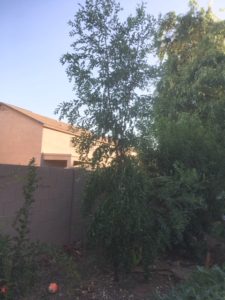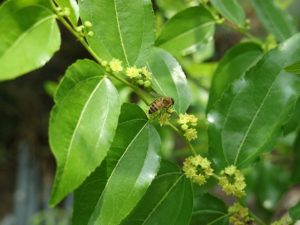Growing a Jujube Tree in Hot, Dry Climates

The only Jujube that I had ever heard of up until a few years ago was the chewy candies. I had a chance to sample a few of the fruit form of Jujube from a local international market and they were good. My wife and kids really loved them, so I decided I better look into growing a Jujube tree. I’ve discovered that growing a Jujube tree in hot, dry climates is one of the easiest fruit trees to grow in our environment.
Jujubes absolutely love our desert heat and don’t seem phased by triple digit temps. In fact, they thrive in the heat.
Another great thing about Jujube trees is that they are cold tolerant, so you don’t have to worry about frost protection.
They actually require a low amount of chill hours. There are two species of Jujube the Indian Jujube and Chinese Jujube.
The Indian Jujube tree is a bit more tropical and isn’t able to handle cold as well as the Chinese Jujube. At my old residence, I had an Indian Jujube, but when I moved into my current home I decided to go with a Chinese variety.
I slightly prefer the taste of the Chinese varieties, but they both taste good. The main reason I went with a Chinese variety the second time was that I didn’t want to worry about cold protection.

Sherwood Jujube
The variety of Jujube that I’m growing is a Chinese Jujube variety called Sherwood Jujube. I was a little concerned when I planted it because I read some things that said it needed another pollinator, so I wasn’t sure if it would produce fruit without a second variety.
In its first year, the tree had one fruit and the second year had around forty, so it definitely can produce without another pollinator.
I believe that most Jujube trees are self-pollinating. One thing I really like about Sherwood Jujube is that it is virtually thornless.
Some varieties of Jujube can be loaded with thorns. Sherwood Jujube is also a very attractive tree with an upright growth habit with weeping branches.
The leaves on the Jujube stay a dark green throughout the year with a somewhat glossy appearance.
Jujube trees grow very rapidly in our climate. When I planted my Jujube as a bare root tree, I chopped it down to knee height about 2 feet tall and it finished the summer around 9 feet.
I then pruned it down to about 7 feet that first winter and it shot up to around 14 feet by the end of the second summer.

Fruiting
Jujubes look similar in size and shape to a date. Some varieties are more rounded about the size of a ping pong ball.
Jujubes start off green and are best eaten when they start turning brown. When you first try a Jujube, the crunch and texture will have you thinking apple.
Jujubes are crisp like an apple, but in my opinion, have more of a sugar water taste. Some Jujube varieties can be left to dry on the tree, which causes them to turn chewy resembling a date.
The Sherwood Jujube variety that I’m growing, doesn’t really taste that great when left to dry on the tree. Jujubes have been used in Chinese medicine for a long time and there are lots of medicinal claims on the internet about the health benefits of Jujube.
Gardening Skill Level
I would say that growing Jujube in a hot, dry climate takes a beginner skill level. This is one of the easiest fruit trees to grow in a hot climate.
There is nothing to worry about when it comes to shade protection or cold protection throughout the year. You can basically stick it in the ground and watch it grow.
They often start producing in their first year, so you don’t have to wait several years to get fruit.
Suitable for Container Growing
I’ve never attempted to grow a Jujube tree in a container, but wouldn’t recommend it. I think that since it grows so rapidly it would be tough to manage in a container.
It would take some serious pruning to keep the tree at a small size and to keep the root system managed. It’s just a better tree for in-ground planting.
Planting Tips
It seems that you can pretty much plant a Jujube anywhere. It doesn’t seem to be affected by our clay soil, the high PH, or poor soil.
I still recommend a spot that has decent drainage, but otherwise, you could plant it anywhere. It isn’t really necessary to amend your soil when planting a Jujube but it doesn’t hurt either. Here is my post on amending clay soil.
Watering
Another great thing about Jujube is they are highly drought tolerant trees. In the hottest parts of the year, I tend to water once per week.
When getting established in the first year you may need to water a little more frequently during the hottest times of the year.
I make sure that I deep water the tree to ensure that the roots are growing deep into the soil.
Feeding
Jujube trees don’t have very demanding feeding requirements, which is surprising for a tree that grows so fast.
I give mine a steady dose of compost throughout the year and occasionally some fish emulsion with liquid seaweed.
I don’t notice any sort of nutrient deficiencies with my Jujube tree.
Sun Exposure
A Jujube tree can thrive in the hottest part of your yard. Think of that spot where everything else has struggled in the heat and a Jujube will most likely do great there.
Jujube doesn’t need any special microclimate and could be placed in an open yard in full sun.
Potential Problems

One of the major problems with Jujube trees is that they can be somewhat of an invasive tree. Jujube trees tend to send up suckers from the root system that can be easily mowed or cut.
I haven’t had too many issues with suckers, but it is something to consider. As with most trees that grow rapidly, I would put them in an appropriate location in your yard.
When Jujube trees are blooming, which is most of the spring and summer, they seem to be a bug magnet. I think the blossoms are pretty fragrant, smelling similar to grape Kool-Aid.
Although it attracts a lot of bugs to the blossoms, I don’t see much of a negative impact from pests adversely affecting the tree or fruit.
I have had some minor damage to some branches from Cicadas that trail through the branch to lay eggs.
Please comment below on anything you enjoyed from this post and your experiences with growing Jujube.
